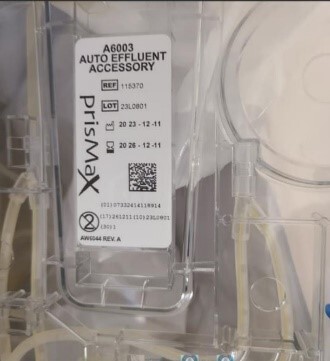|
 
August 2024
Volume 24, Issue 8
The U.S. Food and Drug Administration’s (FDA) MedSun program provides this monthly newsletter to inform patients and patient advocates about FDA information on medical device related topics. The MedSun program, launched in 2002 by the FDA’s Center for Devices and Radiological Health (CDRH), uses a secure online reporting system to receive medical device adverse event reports from a network of over 300 clinical facilities across the United States. MedSun sites work collaboratively with the FDA to assist in detecting, understanding, and sharing information concerning the safety of medical products and play a critical role in the FDA’s postmarket surveillance efforts.
|
|
Letters to Health Care Providers |
|
|
The reports that follow represent a cross section of device related events sent by MedSun Representatives during the prior month. The reports are presented as submitted by MedSun Representatives and in some instances, have been summarized and edited for clarity.
|
|
Type: Sealant, polymerizing
Manufacturer: Baxter Healthcare Corp.
Brand: PREVELEAK Surgical Sealant
UDI-DI: 05413765583582
Model: ADS201808
Lot: HA240106
Ref: ADS201808
Event: The cardiothoracic surgeon requested to use a new product (PREVELEAK) for an open-heart case. The vendor, who was present in the case, had brought in a sample of the product, which was in a box that looked the same as the box that the sterile product was packaged in. Before the case, a registered nurse took the product from the core refrigerator and placed it on a cart in the operating room. During case, the surgeon asked for the product. The vendor had placed the sample product in the same area as the sterile product. When the surgeon requested the PREVELEAK, she touched one of the packages and the vendor said, "Do not open that one, it is my sample product". The registered nurse opened the product which vendor had not touched. At the end of the case, the vendor realized that the opened product was indeed the sample product, which was labeled “nonsterile sample.” Now, the patient must be followed closely to prevent and monitor for any systemic or cardiac infection that may result due to having a nonsterile product placed on his sutures. The user facility identified the following issues:
- The vendor should not bring in sample products into the operating room suite.
- The sample product was in the same looking packaging as the actual product for use, which caused confusion.
- There were no packaging differences to differentiate the sample from the sterile package.
- The sticker with a sample warning was on only one side of the box.
Type: Catheter, intravascular, therapeutic, short Term less than 30 days
Manufacturer: SVS LLC
Brand: PremierPro
UDI-DI: 00811220034795
Model: 31TB20100
Ref: 31TB20100
Event: This facility is experiencing multiple issues in multiple lots with the PremierPro TrueSafe Comfort Blood Control IV Catheter. Reports contain all gauge catheters. Complaints include:
- The catheter would not move forward.
- The catheter withdrew early, causing the vein to blow.
- Accidental leakages are occurring.
- The catheter does not connect to tubing connection well.
- During pressure injection imaging technique, the catheter and connection disconnect.
- The IV would not withdraw after starting, so the entire device was pulled out of the patient's arm to withdraw the needle.

Type: System, hemodialysis, remote accessories
Manufacturer: Baxter Healthcare Corp.
Brand: Auto-Effluent Accessory
Lot: 23L0801
Ref: 115370
Event: A new setup for continuous veno-venous hemofiltration (CVVH), a short term, hospital treatment that removes waste and fluid from the blood when a patient’s kidneys aren’t working properly, was put up. Staff found Auto-Effluent fluid leaking at the connection site. The CVVH machine alarm sounded due to a fluid leak being detected in the tray. The source was from the Auto-Effluent tubing where the connection screws together. Staff could not tighten the connection. Staff recommended reviewing other sets for a possible manufacturing defect.
|
|
|
Neonatal and Pediatric Reports |
|
 |
|
These reports describe medical device events involving neonatal or pediatric patients, or those events involving a medical device that is indicated for use in neonatal and pediatric patient populations.
The FDA defines pediatric patients as those who are 21 years of age or younger (that is, from birth through the twenty-first year of life, up to but not including the twenty-second birthday) at the time of the diagnosis or treatment.
|
Type: Electrosurgical, cutting and coagulation, and accessories
Manufacturer: Symmetry Surgical Inc.
Brand: Bovie
Lot: 0322Z
Cat: AA01
Event: During a pediatric surgery, the patient was masked down for a lysis of penile adhesion (cutting away of scar tissue that connects the foreskin to the glans). When the surgeon used the Bovie High Temperature Fine Tip Cautery, it took a minute to activate and to heat up. Once it warmed up enough, the surgeon started the procedure. The first assistant student noticed the sponge in their hand started turning black and felt warm. They placed the sponge on the portable surgery stand and an ember formed and caught on fire. The surgical tech tossed the sponge on the floor to avoid further spread. The fire was then put out safely with no harm to the patient or others.
Type: Stopcock, I.V. Set
Manufacturer: ICU Medical
Brand: High Pressure Stopcocks (3-Way, Luer lock off) for umbilical lines
Lot: 13707329 (x3), 13689691
Other: 42353-01
Event: A set of twins had the same event occur two days in a row. Both infants had fluid leaking from their umbilical venous catheter (UVC) devices. We were unable to determine if the crack was present before the valves controlling the flow of liquid (stopcocks) were removed from the original packaging, or if excessive pressure was used by someone on two different infants, two days in a row, at two different times of day. I have worked with the stock room to have the 3-Way stopcocks removed from our supply in both of our neonatal intensive care units. Supply chain ordered a new 4-Way stopcock and was made available on supply carts. The infection prevention staff were alerted to monitor both infants for infection, which did not develop. We have had no issue after this change was made.
|
|
Links to FDA CDRH Databases and Other Information Sources |
|
U.S. Food and Drug Administration
10903 New Hampshire Ave.
Silver Spring, MD 20993 |
|
|
|
|